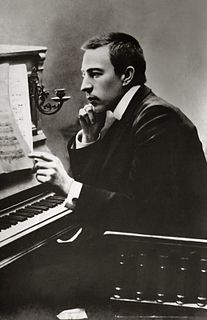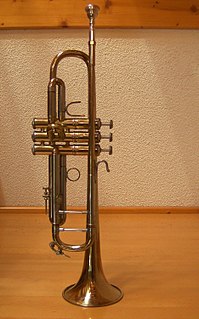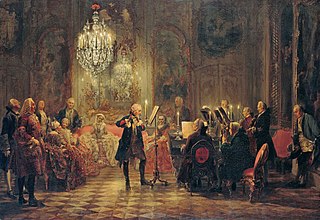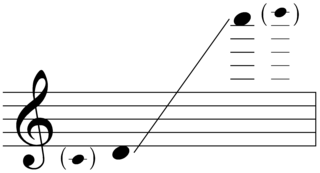
The Piano Concerto No. 2 in C minor, Op. 18, is a concerto for piano and orchestra composed by Sergei Rachmaninoff between the autumn of 1900 and April 1901. The second and third movements were first performed with the composer as soloist on 2 December 1900. The complete work was premiered, again with the composer as soloist, on 9 November 1901, with his cousin Alexander Siloti conducting.
Sir James Loy MacMillan, CBE is a Scottish classical composer and conductor.
Century Rolls is a piano concerto by the American composer John Adams. Commissioned by Emanuel Ax, the work dates from 1997. Ax was the soloist in the concerto's premiere on September 25, 1997 in Cleveland, Ohio, with Christoph von Dohnányi conducting The Cleveland Orchestra. Ax, von Dohnányi and The Cleveland Orchestra made the first commercial recording of the concerto, for Nonesuch. Adams himself conducted the UK premiere on 1 November 1998, again with Ax as the piano soloist.
The Sacrifice is an opera in three acts composed by James MacMillan with a libretto by the poet Michael Symmons Roberts based on the Branwen story of the Welsh mythology collection, the Mabinogion. The world premiere took place on 22 September 2007 at the Donald Gordon Theatre of the Wales Millennium Centre, Cardiff. The production was staged by Welsh National Opera, directed by Katie Mitchell and conducted by the composer.

The trumpet repertoire consists of solo literature and orchestral or, more commonly, band parts written for the trumpet. Tracings its origins to 1500 BC, the trumpet is a musical instrument with the highest register in the brass family.
The Concerto for Orchestra is an orchestral composition by the American composer Christopher Rouse. The work was commissioned by the Cabrillo Festival of Contemporary Music and is dedicated to conductor and frequent Rouse collaborator Marin Alsop. The piece was completed February 24, 2008 and premiered at the festival August 1, 2008, with Marin Alsop leading the Cabrillo Festival Orchestra.
The Percussion Concerto No. 2 is a concerto for solo percussion and orchestra by the Scottish composer James MacMillan. The work was jointly commissioned by the Netherlands Radio Philharmonic, the Philharmonia Orchestra, the Orchestre national du Capitole de Toulouse, the Cabrillo Festival of Contemporary Music, the Baltimore Symphony Orchestra, and the São Paulo State Symphony. It was first performed on November 7, 2014 at TivoliVredenburg in Utrecht, the Netherlands, by percussionist Colin Currie and the Netherlands Radio Philharmonic under conductor James Gaffigan. The composition is MacMillan's second percussion concerto after 1992's Veni, Veni, Emmanuel.
The Symphony No. 4 is the fourth symphony by the Scottish composer James MacMillan. The work was composed in celebration of the conductor Donald Runnicles's 60th birthday. It was premiered at The Proms on August 3, 2015 by the BBC Scottish Symphony Orchestra under Donald Runnicles.
The Violin Concerto is a composition for solo violin and orchestra by the Scottish composer James MacMillan. The piece was first performed at the Barbican Centre on May 12, 2010 by the violinist Vadim Repin and the London Symphony Orchestra under the conductor Valery Gergiev. The work is dedicated to Vadim Repin and in memoriam of the composer's mother, Ellen MacMillan.
The Cello Concerto is a composition for solo cello and orchestra by the Scottish composer James MacMillan. It is the second of three interrelated compositions in MacMillan's Easter triptych Triduum commissioned by the London Symphony Orchestra. The piece was first performed at the Barbican Centre on October 3, 1996 by the cellist Mstislav Rostropovich and the London Symphony Orchestra under the conductor Colin Davis. The work is dedicated to Mstislav Rostropovich.
The Concerto No. 3 for Piano and Orchestra "The Mysteries of Light" is the third piano concerto by the Scottish composer James MacMillan. The work was commissioned by the Minnesota Orchestra and was first performed on April 14, 2011 in Orchestra Hall, Minneapolis, by the pianist Jean-Yves Thibaudet and the Minnesota Orchestra under the conductor Osmo Vänskä.
The Symphony No. 1 or Symphony: 'Vigil' is an orchestral symphony by the Scottish composer James MacMillan. It is the last of three interrelated compositions in MacMillan's Easter triptych Triduum commissioned by the London Symphony Orchestra. The piece was first performed at the Barbican Centre on 28 September 1997 by the London Symphony Orchestra under the conductor Mstislav Rostropovich.
The Piano Concerto No. 2 is a composition for solo piano and string orchestra by the Scottish composer James MacMillan. The work was commissioned by the New York City Ballet and was first performed at Lincoln Center for the Performing Arts on May 8, 2004, by the pianist Cameron Grant and the New York City Ballet Orchestra under MacMillan. The original ballet performance was choreographed by Christopher Wheeldon. The piece is dedicated in memory of the poet Edwin Muir.
The Concerto for Clarinet is a composition for solo clarinet and orchestra by the American composer Joan Tower. The work was commissioned by the Walter W. Naumburg Foundation for the clarinetist Charles Neidich, to whom the piece is dedicated.
The Piano Concerto No. 3 is a composition for solo piano and orchestra by the American composer Peter Lieberson. The work was commissioned by the Minnesota Orchestra for the ensemble's centennial. It was given its world premiere by the pianist Peter Serkin and the Minnesota Orchestra in Minneapolis on November 26, 2003. The piece is dedicated to Peter Serkin and was a finalist for the 2004 Pulitzer Prize for Music.
The Viola Concerto is a composition for viola and orchestra by the Scottish composer James MacMillan. The work was jointly commissioned by the London Philharmonic Orchestra, the Lucerne Symphony Orchestra, the Bergen Philharmonic Orchestra, and the Adelaide Symphony Orchestra. Its world premiere was given by the violist Lawrence Power and the London Philharmonic Orchestra under the direction of Vladimir Jurowski in the Royal Festival Hall, London, on 15 January 2014. The piece is dedicated to Lawrence Power.
The World's Ransoming is a concerto for cor anglais and orchestra by the Scottish composer James MacMillan. It was the first of three interrelated compositions in MacMillan's Easter triptych Triduum commissioned by the London Symphony Orchestra. Its world premiere was given by the soloist Christine Pendrill and the London Symphony Orchestra under the direction of Kent Nagano at the Barbican Centre on 11 July 1996.
A Scotch Bestiary: Enigmatic Variations on a Zoological Carnival at a Caledonian Exhibition is an organ concerto by the Scottish composer James MacMillan. The work was commissioned by the BBC and the Los Angeles Philharmonic. It was composed from 2003 to 2004 and was first performed by the organist Wayne Marshall and the Los Angeles Philharmonic under the direction of Esa-Pekka Salonen at the Walt Disney Concert Hall on October 7, 2004.
The Piano Concerto No. 4 for Left Hand and Orchestra is the fourth piano concerto by the American composer Ned Rorem. It was commissioned by the Curtis Institute of Music for the pianist Gary Graffman. The work was first performed by Graffman and the Curtis Institute of Music Orchestra conducted by André Previn at the Academy of Music, Philadelphia, on February 4, 1993. Its New York City premiere was performed the next day by the same ensemble at Carnegie Hall. A then-unknown Hilary Hahn performed a solo violin section for both performances.
The Cello Concerto is a composition for cello and orchestra by the Finnish composer Esa-Pekka Salonen. The work was co-commissioned by the Chicago Symphony Orchestra, the New York Philharmonic, the Barbican Centre, and the Elbphilharmonie. It was completed in 2017 and was first performed by the cellist Yo-Yo Ma and the Chicago Symphony Orchestra under the direction of Salonen on March 9, 2017. The piece is dedicated to Yo-Yo Ma.











